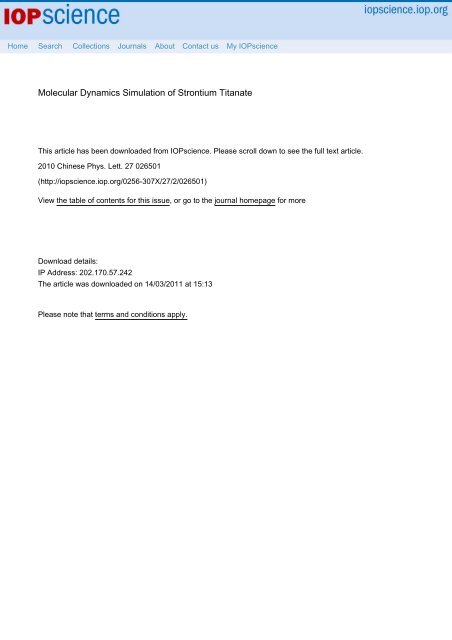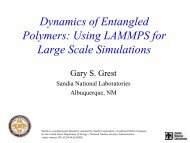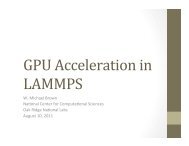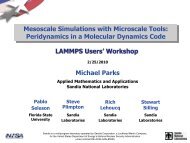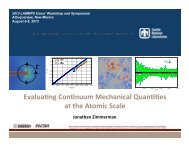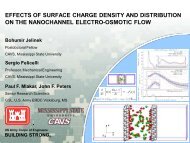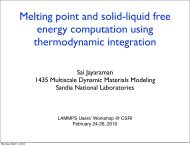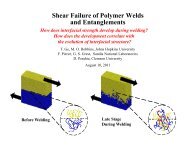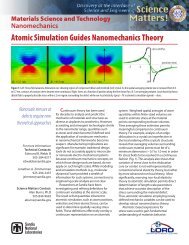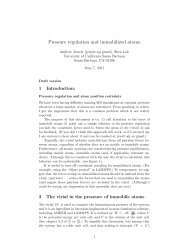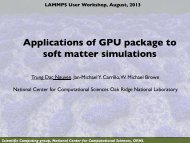Molecular Dynamics Simulation of Strontium Titanate - Lammps
Molecular Dynamics Simulation of Strontium Titanate - Lammps
Molecular Dynamics Simulation of Strontium Titanate - Lammps
Create successful ePaper yourself
Turn your PDF publications into a flip-book with our unique Google optimized e-Paper software.
Home Search Collections Journals About Contact us My IOPscience<br />
<strong>Molecular</strong> <strong>Dynamics</strong> <strong>Simulation</strong> <strong>of</strong> <strong>Strontium</strong> <strong>Titanate</strong><br />
This article has been downloaded from IOPscience. Please scroll down to see the full text article.<br />
2010 Chinese Phys. Lett. 27 026501<br />
(http://iopscience.iop.org/0256-307X/27/2/026501)<br />
View the table <strong>of</strong> contents for this issue, or go to the journal homepage for more<br />
Download details:<br />
IP Address: 202.170.57.242<br />
The article was downloaded on 14/03/2011 at 15:13<br />
Please note that terms and conditions apply.
CHIN. PHYS. LETT. Vol. 27, No. 2 (2010) 026501<br />
<strong>Molecular</strong> <strong>Dynamics</strong> <strong>Simulation</strong> <strong>of</strong> <strong>Strontium</strong> <strong>Titanate</strong><br />
SEETAWAN Tosawat 1* , WONG-UD-DEE Gjindara 1 , THANACHAYANONT Chanchana 2 ,<br />
AMORNKITBUMRUNG Vittaya 3<br />
1 Thermoelectrics Research Center and Department <strong>of</strong> Physics, Faculty <strong>of</strong> Science and Technology, Sakon Nakhon<br />
Rajabhat University, 680 Nithayo Rd., Sakon Nakhon, 47000, Thailand<br />
2 National Metal and Materials Technology Center, 114 Thailand Science Park, Paholyothin Rd., Klong 1, Klong<br />
Luang, Pathumthani, 12120, Thailand<br />
3 Integrated Nanotechnology Research Center and Department <strong>of</strong> Physics, Faculty <strong>of</strong> Science, Khon Kaen University,<br />
123 Mitrapab Rd., Khon Kaen, 40002, Thailand<br />
(Received 5 May 2009)<br />
The molecular dynamics method is used to simulate the thermophysical properties <strong>of</strong> SrTiO 3 thermoelectric<br />
material in the temperature range 300–2200 K. The Morse-type potential functions added to the Busing–Ida<br />
type potential for interatomic interaction are used in the simulation. The interatomic potential parameters are<br />
determined by fitting to the experimental data <strong>of</strong> lattice parameters with temperature and the data reported<br />
in literature. The linear thermal expansion coefficient, heat capacity and lattice contributions to the thermal<br />
conductivity are analyzed. The results agree with the data reported in the literature.<br />
PACS: 65. 40. −b, 31. 15. Qg, 47. 11. Mn<br />
DOI: 10.1088/0256-307X/27/2/026501<br />
<strong>Strontium</strong> titanate (SrTiO 3 ) is a perovskite-type<br />
oxide, ceramic material. It has shown photonic conductivity<br />
at high temperature, [1] a large potential for<br />
use in fuel cells, steam electrolysis and hydrogen gas<br />
sensors, [2−4] oxygen-gas sensors, [5] usage as a grainboundary<br />
barrier layer capacitor, [6,7] epitaxial growth<br />
substrate <strong>of</strong> high temperature superconductor thin<br />
films, [8] catalytic material and dielectric material, [9,10]<br />
n-type thermoelectric material; [11] the thermal conductivity<br />
is 10 Wm −1 K −1 at 300 K. [11] In experiment,<br />
SrTiO 3 has been employed to elucidate the transport<br />
mechanism at protons, [12] infrared absorption<br />
spectra [13] and conductivity charges with temperature<br />
following thermal activation-type behavior. [14] In theory,<br />
SrTiO 3 shows crystallographic cubic structure, its<br />
space group number is 221, P m¯3m, the lattice parameters<br />
are a = b = c = 0.39050 nm, the number<br />
<strong>of</strong> atoms in the unit cell is 5. Recently, we reported<br />
thermophysical properties <strong>of</strong> PuO 2 and AmO 2 simulated<br />
by molecular dynamics and the electronic structures<br />
<strong>of</strong> SrTiO 3 calculated by the DV-Xα molecular<br />
orbital method, in agreement with the experimental<br />
data. [15,16]<br />
The molecular dynamics program is based on<br />
MXDORTO, [17] SrTiO 3 is performed for a system <strong>of</strong><br />
320 ions (O = 192, Ti = 64, Sr = 64), as shown in Table<br />
1. The thermophysical properties are simulated in<br />
the temperature range from 300 to 2200 K in the pressure<br />
range 0.1–1.5 GPa, composed <strong>of</strong> the linear thermal<br />
expansion coefficient α lin , the heat capacity at<br />
constant volume C V , the heat capacity <strong>of</strong> lattice dilational<br />
term C d , the heat capacity at constant pressure<br />
C P , and lattice contributions to the thermal conductivity<br />
κ lat . Here α lin is evaluated by<br />
α lin = 1 (︂ a(T ) − a(T0 )<br />
, (1)<br />
a(T 0 ) T − T 0<br />
)︂P<br />
where a(T ) is the lattice parameter at T (K) evaluated<br />
from the interatomic potential parameters, and T 0 is<br />
room temperature. C V , C d , and C P are evaluated by<br />
(︂ )︂ ∂∂E(T )<br />
C V =<br />
, (2)<br />
∂∂T<br />
C d = (3α lin) 2 V T<br />
β<br />
V<br />
, (3)<br />
C P = C V + C d , (4)<br />
where E(T ) is the internal energy at T (K), and V<br />
is the molar volume, κ lat is calculated by the Green–<br />
Kubo relation, [17]<br />
κ =<br />
V ∫︁ ∞<br />
3k B T 2 ⟨S(t) · S(0)⟩dt, (5)<br />
0<br />
where k B is the Boltzmann constant (1.38066 ×<br />
10 −23 J·K −1 ), and S(t) is the heat flux autocorrelation<br />
function (ACF)<br />
S(t) = 1 [︂ ∑︁<br />
e j v j − 1 ∑︁ ∑︁<br />
]︂<br />
r ij (f ij · v j ) , (6)<br />
V<br />
2<br />
j<br />
j i=j<br />
and the instantaneous excess energy <strong>of</strong> atom j, i.e. e j ,<br />
is described as<br />
⎧<br />
⎫<br />
⎨<br />
1<br />
e j =<br />
⎩2 m jvj 2 + 1 ∑︁ ⎬<br />
u(r ij )<br />
2 ⎭ − e av, (7)<br />
i=j<br />
* Email: tosawatseetawan@yahoo.com<br />
c○ 2010 Chinese Physical Society and IOP Publishing Ltd<br />
026501-1
CHIN. PHYS. LETT. Vol. 27, No. 2 (2010) 026501<br />
where m j and v j are the mass and velocity <strong>of</strong> atom<br />
j; r ij , f ij , and u are the interatomic distance, force,<br />
and potential between atom i and j; e av is the average<br />
energy <strong>of</strong> SrTiO 3 . We employ the semi-empirical twobody<br />
potential function proposed by Ida for cationanion<br />
interaction. [18] The potential is a partially ionic<br />
model including a covalent contribution:<br />
U ij (r ij ) = z iz j e 2<br />
(︂ )︂<br />
ai + a j − r ij<br />
+ f 0 (b i + b j ) exp<br />
r ij<br />
b i + b j<br />
− c ic j<br />
{︀<br />
rij<br />
6 + D ij exp[−2βij (r ij − r ij)]<br />
*<br />
− 2 exp[−β ij (r ij − r ij)] * }︀ , (8)<br />
where z i and z j are the effective partial electronic<br />
charges on the ith and jth ions, r ij is the interatomic<br />
distance, r ij<br />
* is the bond length <strong>of</strong> the cation-anion<br />
pair in vacuum, a, b, and c are characteristic parameters<br />
depending on the ion species, f 0 = 4.19; D ij and<br />
β ij are the depth and shape <strong>of</strong> this potential, respectively.<br />
The potential parameters and characteristic<br />
parameters are summarized in Table 1.<br />
Table 1.<br />
SrTiO 3 .<br />
Values <strong>of</strong> the interatomic potential function for<br />
Ions z a b c Pairs D ij β ij r ij<br />
O 2− (192) −1.2 1.926 0.160 20<br />
Ti 4+ (64) 2.4 1.055 0.180 25 Ti-O 4.23 3.82 2.1923<br />
Sr 2+ (64) 1.2 1.198 0.160 10 Sr-O 2.41 1.18 2.7615<br />
changed with pressure in the range from 0.1 GPa to<br />
1.5 GPa at room temperature. These results indicate<br />
that the potential function in the present simulations<br />
describes the changes in the lattice parameters with<br />
both temperature and pressure.<br />
Figure 2 shows the temperature dependence <strong>of</strong> α lin<br />
<strong>of</strong> SrTiO 3 . Here α lin value is 0.57×10 −5 K −1 at 300 K,<br />
and it increases to 1.23×10 −5 K −1 at 2200 K. However,<br />
the evaluated values <strong>of</strong> α lin swing at the temperature<br />
range 1050–1500 K because the SrTiO 3 structure has<br />
changed to a tetragonal structure and attains the cubic<br />
structure <strong>of</strong> SrTiO 3 again at high temperature.<br />
Linear thermal expension<br />
coefficient lin (10 -5 K -1 )<br />
1.1<br />
1.0<br />
0.9<br />
0.8<br />
0.7<br />
0.6<br />
0.5<br />
0 400 800 1200 1600 2000<br />
Temperature (K)<br />
Fig. 2. Temperature dependence <strong>of</strong> the linear thermal expansion<br />
coefficient for SrTiO 3 , together with de Ligny et<br />
al. [19] 0 400 800 1200 1600 2000<br />
Lattice parameter (nm)<br />
0.398 Our result<br />
Muta . 2005<br />
PCPDF#011018<br />
PCPDF#021454<br />
0.396<br />
PCPDF#401500<br />
PCPDF#840444<br />
0.394<br />
0.392<br />
0.390<br />
0 400 800 1200 1600 2000<br />
Temperature (K)<br />
Fig. 1. Temperature dependence <strong>of</strong> the lattice parameter<br />
for SrTiO 3 , together with PCPDF # 011018, 021454,<br />
401500, 840444, and Muta et al. [11]<br />
Figure 1 shows the temperature dependence <strong>of</strong> the<br />
lattice parameter <strong>of</strong> SrTiO 3 evaluated by the MD<br />
method, together with the PCPDFWIN Card Nos<br />
011018, 021454, 401500, 840444, and Muta et al. [11]<br />
The lattice parameter <strong>of</strong> about 0.389 nm at 300 K increases<br />
to 0.397 nm at 2200 K. The evaluated values<br />
<strong>of</strong> lattice parameter at room temperature keep up a<br />
correspondence with the PCPDF#021454. However,<br />
the evaluated results with other PCPDF Cards and<br />
Muta et al. [11] are slightly lower and higher in the order<br />
<strong>of</strong> pico-meters. The lattice parameter <strong>of</strong> SrTiO 3<br />
Heat capacity (JSmol -1 SK -1 )<br />
140<br />
120<br />
100<br />
80<br />
3<br />
2<br />
1<br />
0<br />
Temperature<br />
(K)<br />
Fig. 3. Temperature dependence <strong>of</strong> the heat capacity at<br />
constant volume and the heat capacity <strong>of</strong> lattice dilatational.<br />
Figure 3 shows the temperature dependence <strong>of</strong> C V ,<br />
and C d <strong>of</strong> SrTiO 3 . C V is 81.50 Jmol −1 K −1 at 300 K,<br />
and it increases to 136.37 Jmol −1 K −1 at 1800 K. C d<br />
is 0.0396 Jmol −1 K −1 at 400 K, and it increases to<br />
2.2995 Jmol −1 K −1 at 1800 K. However, the C d and C V<br />
values show systematic differences at high temperature,<br />
which indicates the cubic structure (P m¯3m). [19]<br />
Temperature dependence <strong>of</strong> C P <strong>of</strong> SrTiO 3 is shown in<br />
Fig. 4, together with de Ligny et al. [19] and Coughlin et<br />
026501-2
CHIN. PHYS. LETT. Vol. 27, No. 2 (2010) 026501<br />
al. [20] C P is 90.08 Jmol −1 K −1 at 400 K, and it increases<br />
to 138.66 Jmol −1 K −1 at 1800 K, this agrees with the<br />
data in the literature, which indicates that the potential<br />
function used in the present study describes well<br />
the change in the internal energy <strong>of</strong> SrTiO 3 with temperature.<br />
Heat capacity (JSmol -1 SK -1 )<br />
140<br />
130<br />
120<br />
110<br />
100<br />
90<br />
Our result<br />
de Ligny . 1996<br />
Coughlin . 1953 ( )<br />
0 400 800 1200 1600 2000<br />
Temperature (K)<br />
Fig. 4. Temperature dependence <strong>of</strong> the heat capacity at<br />
constant pressure for SrTiO 3 , together with de Ligny et<br />
al. [19] and Coughlin et al. [20]<br />
Thermal coductivity<br />
lat (Wm -1 K -1 )<br />
10<br />
8<br />
6<br />
4<br />
Our result<br />
Muta . 2005<br />
Ito . hot-press at 1473 K<br />
Ito . hot-press at 1673 K<br />
400 600 800 1000<br />
Temperature (K)<br />
Fig. 5. Temperature dependence <strong>of</strong> lattice contributions<br />
to the thermal conductivity for SrTiO 3 , together with<br />
Muta et al. [11] and Ito et al. [21]<br />
Figure 5 shows the temperature dependence <strong>of</strong> κ lat<br />
<strong>of</strong> SrTiO 3 , together with Muta et al. [11] and Ito et<br />
al. [21] Here the κ lat value is 12.64 Wm −1 K −1 at 300 K,<br />
and it decreases to 2.25 Wm −1 K −1 at 1100 K, it almost<br />
agrees with the data <strong>of</strong> Muta et al. [11] in the<br />
temperature range from 300 to 800 K. It indicates that<br />
our model can describe the thermal conductivity <strong>of</strong><br />
SrTiO 3 . Of course, the total thermal conductivity<br />
κ total is evaluated from the relationship:<br />
κ total = κ lat + κ el + κ other , (9)<br />
where κ el is the electrical contribution to the thermal<br />
conductivity, and κ other is the other contribution to<br />
the thermal conductivity. The evaluated results <strong>of</strong> the<br />
molecular dynamics simulation represent κ lat only.<br />
In summary, the molecular dynamics method has<br />
been used in simulation <strong>of</strong> the thermophysical properties<br />
<strong>of</strong> SrTiO 3 .We obtain the results that the lattice<br />
parameter, linear thermal expansion coefficient, and<br />
heat capacity increase with increasing temperature,<br />
and the decreases <strong>of</strong> lattice contributions on the thermal<br />
conductivity with increasing temperature agree<br />
with data in the literature. It shows that the molecular<br />
dynamics simulation is very useful for evaluating<br />
the thermophysical properties <strong>of</strong> thermoelectric materials<br />
such as SrTiO 3 . Supported by the Commission<br />
on Higher Education, CHE-RES-PD project, Ministry<br />
<strong>of</strong> Education, Thailand.<br />
References<br />
[1] Iwahara H, Esaka T, Uchida H, Macula N 1981 Solid State<br />
Ionics 3/4 359<br />
[2] Iwahara H, yajima T, Hibino T, Ushida H 1993<br />
J. Electrochem. Soc. 140 1687<br />
[3] Kurita N, Fukatsu N, Ohashi T 1994 J. Spn. Inst. Metals 58<br />
782<br />
[4] Yajima T, Koide K, Takai H, Fukatsu N, Iwahara H 1995<br />
Solid State Ionics 79 333<br />
[5] Gerblinger J, Meixner H 1991 Sensors Actuators 4 99<br />
[6] Fujimoto M, Kingery W D 1985 J. Am. Ceram. Soc. 68 169<br />
[7] Yamaoka N, Masuyama M, Fukui M 1983<br />
Am. Ceram. Soc. Bull. 62 698<br />
[8] Kawai M, Watanabe S, Hanada T 1991 J. Crystal Growth.<br />
112 745<br />
[9] Mavroides J G, kafalas J A, Kolesar D F 1976<br />
Appl. Phys. Lett. 28 241<br />
[10] Henrich V E 1985 Rep. Prog. Phys. 48 1481<br />
[11] Muta H, Kurosaki K and Yamanaka S 2005 J. Alloy Compd.<br />
392 306<br />
[12] Matsushita E and Tanase A 1997 Solid State Ionics 97 45<br />
[13] Sata N, Hiramoto K and Ishigame M 1996 Phys. Rev. B 54<br />
15795<br />
[14] Yukawa H, Nakatsuka K and Morinaga M 1999 Solid State<br />
Ionics 116 89<br />
[15] Seetawan T, Khuangthip T, Amornkitbamrung V, Kurosaki<br />
K, Adachi J., Katayama M, Charoenphakdee A and Yamanaka<br />
S 2008 Master. Rec. Soc. Symp. Proc. (USA: Materials<br />
Research Society) vol 1043 p 1043-T09-09<br />
[16] Seetawan T, Vora-ud A and Amornkitbamrung V 2008<br />
Siam Physics Congress (Khao Yai, Nakhon Ratchasima,<br />
Thailand 20–22 March 2008) A-9<br />
[17] Zwanzig R 1965 Ann. Rev. Phys. Chem. 16 67<br />
[18] Zhang Q Y, Jiang S W and Li Y R 2006<br />
J. Comput. Aid. Mol. Des. 13 213<br />
[19] de Ligny D and Richet P 1996 Phys. Rev. B 53 3013<br />
[20] Coughlin J P and Orr R L 1953 J. Am. Chem. Soc. 75 530<br />
[21] Ito M and Matsuda T 2009 J. Alloy Compd. 477 473<br />
026501-3


